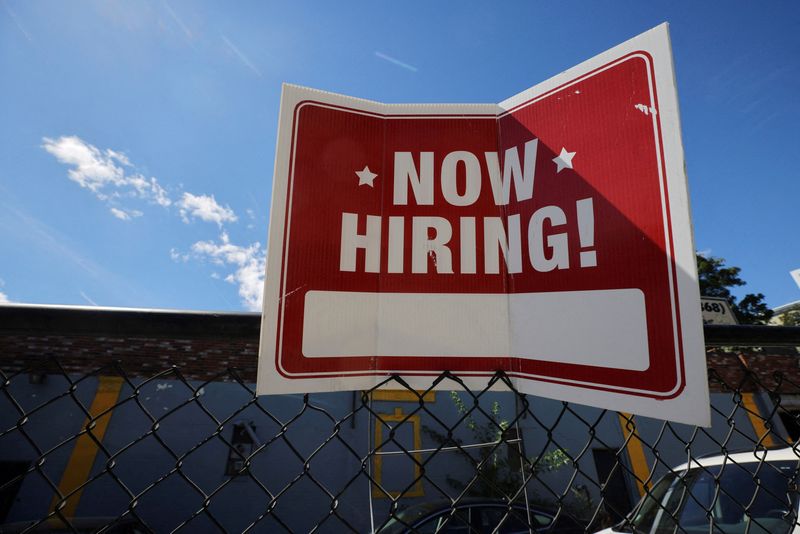By Lucia Mutikani
WASHINGTON (Reuters) - U.S. employers hired more workers than expected in December while raising wages at a solid clip, casting some doubt on financial market expectations that the Federal Reserve would start cutting interest rates in March.
There were, however, some cracks in the closely watched employment report from the Labor Department on Friday. The economy added 71,000 fewer jobs in October and November than previously reported. While the unemployment rate held at 3.7% last month, that was because 676,000 people left the labor force, almost erasing all the gains in participation since February. Household employment fell sharply and the workweek was on average slightly shorter than in November.
Nonetheless, the report indicated that the economy avoided a recession last year and would likely continue to grow through 2024 as labor market resilience supports consumer spending.
"A gradual labor market cooldown remains in place," said Scott Anderson, chief U.S. economist at BMO Capital Markets in San Francisco. "However, the lingering labor market resilience and strength in wage growth could keep the Fed on the sidelines for longer than the markets currently expect."
Nonfarm payrolls increased by 216,000 jobs last month, the Labor Department's Bureau of Labor Statistics said. Economists polled by Reuters had forecast payrolls rising by 170,000 jobs. The economy added 2.7 million jobs in 2023, a sharp step-down from the 4.8 million positions created in 2022.
That reflected cooling demand in the economy following 525 basis points worth of rate hikes from the U.S. central bank since March 2022. Roughly 100,000 jobs per month are needed to keep up with growth in the working age population.
Government hiring as state and local authorities try to bring education staffing back to pre-pandemic levels led the rise in employment last month, with 52,000 jobs added.
Government payrolls growth averaged 56,000 jobs per month in 2023, more than double the average monthly gain of 23,000 in 2022. Employment in the healthcare sector increased 38,000, spread across ambulatory healthcare services and hospitals. Unseasonably mild weather boosted hiring at construction sites, with payrolls in the industry rising 17,000.
Leisure and hospitality employment gained 40,000. Employment in the industry is below levels seen before the COVID-19 pandemic by 163,000. Retail employment rose 17,400.
Professional and business services payrolls rose 13,000, but temporary help services shed another 33,300 positions. Employment in the sector, seen as a harbinger for future hiring, has declined for 11 straight months.
Manufacturing jobs increased 6,000. But employment in the transportation and warehousing industry fell 22,600.
The labor market generally remains tight, with 1.40 job openings per every unemployed person in November. That is feeding through to wages, which remain elevated.
Average hourly earnings rose 0.4% in December, matching the prior month's gain. That raised the year-on-year increase in wages to 4.1% from 4.0% in November.
Wage growth is well above its pre-pandemic average and the 3-3.5% range that most policymakers view as consistent with the Fed's 2% inflation target.
Financial markets initially reduced the probabilities of a March rate cut to around 53% but later boosted them to about 65% as traders digested the mixed employment report. Attention now shifts to December's consumer inflation report, scheduled to be published next Thursday.
Stocks on Wall Street were mixed. The dollar slipped against a basket of currencies. U.S. Treasury prices fell.
SOFT HOUSEHOLD DETAILS
The Fed held its policy rate steady in the current 5.25%-5.50% range last month and policymakers signaled in new economic projections that the historic monetary policy tightening engineered over the last two years is at an end and lower borrowing costs are coming in 2024.
There was an increase in the share of industries reporting job growth last month, helping to assuage concerns that hiring was too concentrated in a few sectors.
With December's employment report, the government incorporated annual revisions to the seasonally adjusted household survey data, from the which the unemployment rate is derived, for the past five years.
The revisions had little impact on the jobless rate or the labor force participation rate. The unemployment rate has risen from a five-decade low of 3.4% in April amid an influx of people into the labor force, some of it tied to a rise in immigration.
But the trend reversed in December, with 676,000 people leaving the workforce. As a result the labor force participation rate, or the proportion of working-age Americans who have a job or are looking for one, fell to 62.5%. That was the lowest level since February and was down from 62.8% in November. The prime working-age participation rate was the lowest since March.
Both women and men saw a drop in participation, which also fell for foreign-born and American-born workers. Some economists speculated that year-end retirements accounted for the decline in both household employment and the workforce.
"It looks like monthly volatility may have played a role, but we won't know for sure until next month's release," said Daniel Vernazza, chief international economist at UniCredit Bank in London.
Household employment plunged 683,000. It is, however, very volatile. The employment-to-population ratio, viewed as a measure of an economy's ability to create employment, fell to a one-year low of 60.1% from 60.4% in November.
More people worked part-time for economic reasons, with the number increasing 217,000. A broader measure of unemployment, which includes people who want to work but have given up searching and those working part-time because they cannot find full-time employment, rose to 7.1% from 7.0% in November.
"The labor market is not as tight as you think," said Sung Won Sohn, finance and economics professor at Loyola Marymount University in Los Angeles. "I am still expecting the Fed to cut rates at least a couple of times in the first half of the year."
